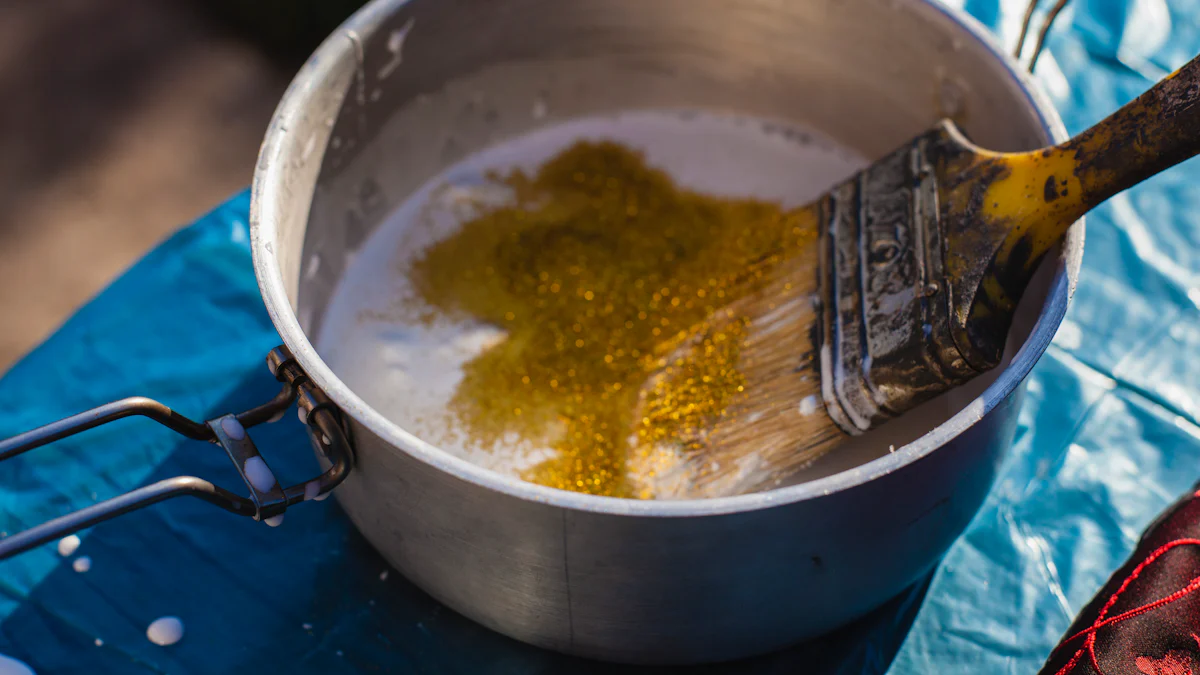Mastering Cookware Repairs with Aluminum Rivets

Repairing cookware with aluminum rivets can transform your kitchen experience. You not only save money but also extend the life of your beloved pots and pans. Imagine the satisfaction of fixing cookware spare parts yourself, knowing you’ve avoided costly replacements. Plus, DIY repairs empower you to tackle other household tasks. Many homeowners spend thousands on repairs, but you can cut costs significantly by mastering this skill. Moreover, maintaining your cookware spare parts ensures safety by preventing toxic metal leaching, which poses health risks. Embrace the art of DIY and enjoy the benefits of a well-maintained kitchen.
Tools and Materials Needed for Cookware Spare Parts
When you’re ready to dive into repairing your cookware, having the right tools and materials is crucial. Let’s break down what you’ll need to get started.
Essential Tools
To tackle any repair job, you need a few key tools:
-
Rivet Gun
A rivet gun is your primary tool for installing new rivets. It helps you secure the cookware spare parts firmly. Make sure you choose one that’s comfortable to handle and easy to operate.
-
Drill and Drill Bits
Drilling out old rivets requires precision. A good drill with the right bits ensures you can remove worn-out rivets without damaging the cookware. Opt for bits that match the size of your new rivets, typically around 1/8 inch.
-
Hammer
Sometimes, a simple hammer is all you need to set a rivet in place. It’s handy for those final taps to ensure everything is snug and secure.
Necessary Materials
With your tools ready, gather these materials to complete your repair:
-
Aluminum Rivets
Aluminum rivets are ideal for cookware due to their ability to withstand high heat. They provide a strong hold and are less likely to corrode over time. Choose the right size to match your cookware’s needs.
-
Replacement Handles or Parts
If your cookware has broken handles or other damaged parts, you’ll need replacements. Ensure they fit well with your existing cookware to maintain functionality and safety.
-
Safety Gear (Gloves, Goggles)
Safety should always come first. Wear gloves to protect your hands from sharp edges and goggles to shield your eyes from flying debris during drilling.
By equipping yourself with these tools and materials, you’re well on your way to mastering cookware repairs. Not only will you extend the life of your cookware spare parts, but you’ll also gain the satisfaction of doing it yourself. Remember, maintaining your cookware not only saves money but also contributes to a safer kitchen environment.
Step-by-Step Repair Guide
Ready to dive into the world of cookware repairs? This guide will walk you through each step, ensuring you handle your cookware spare parts like a pro.
Preparation
Before you begin, preparation is key. Let’s start by assessing what needs fixing.
Assessing the Damage
First, take a close look at your cookware. Check for loose handles, wobbly lids, or any other signs of wear and tear. Identifying the problem areas helps you focus your efforts where they’re needed most. This step ensures you don’t miss any hidden issues that could cause trouble later.
Gathering Tools and Materials
Once you’ve assessed the damage, gather all the necessary tools and materials. Having everything at hand saves time and keeps the process smooth. You’ll need your rivet gun, drill, hammer, aluminum rivets, replacement parts, and safety gear. With these ready, you’re set to tackle the repair.
Riveting Techniques
Now, let’s get into the riveting techniques. This part is where the magic happens.
Drilling Out Old Rivets
Start by drilling out the old rivets. Use your drill and the appropriate bit size, usually around 1/8 inch. Be gentle to avoid damaging the cookware. This step clears the way for new rivets, ensuring a fresh start.
Aligning New Parts
Next, align the new parts with the existing cookware. Make sure everything fits snugly. Proper alignment is crucial for stability and functionality. Take your time here to ensure a perfect fit.
Installing New Rivets
With everything aligned, it’s time to install the new rivets. Use your rivet gun to secure them in place. A few firm squeezes should do the trick. This step locks everything together, restoring your cookware to its former glory.
Finishing Touches
You’re almost done! Let’s add those finishing touches to ensure everything is perfect.
Checking for Stability
Give your cookware a good shake to check for stability. Everything should feel solid and secure. If anything seems loose, tighten it up. This step ensures your repairs hold up under regular use.
Cleaning and Polishing
Finally, clean and polish your cookware. Remove any debris from the repair process and give it a nice shine. This step not only makes your cookware look great but also prolongs its life.
By following this guide, you can confidently repair your cookware spare parts. You’ll save money, extend the life of your kitchen essentials, and enjoy the satisfaction of a job well done. Remember, practice makes perfect, so don’t hesitate to tackle more repairs as needed.
Troubleshooting Common Issues
Even with the best tools and techniques, you might encounter some hiccups during your cookware repair journey. Let’s dive into common issues and how to tackle them effectively.
Rivet Not Holding
Sometimes, you might find that a rivet doesn’t hold as securely as it should. This can be frustrating, but understanding the root causes can help you fix it.
Possible Causes
- Incorrect Rivet Size: Using a rivet that’s too small or too large for the hole can lead to a weak hold.
- Improper Installation: If the rivet gun isn’t used correctly, the rivet might not expand fully, resulting in a loose fit.
- Material Mismatch: Rivets work best when they match the materials they’re joining. For instance, aluminum rivets are ideal for aluminum cookware.
- Expert Testimony: “Riveting can be the ideal solution. Rivets can effectively join dissimilar materials, such as metal and plastic, where welding might not be suitable or even possible.”
Solutions
- Check Rivet Size: Ensure you’re using the correct size for your cookware spare parts. A snug fit is crucial for stability.
- Reinstall Properly: Practice using the rivet gun to ensure you’re applying enough pressure for a secure hold.
- Match Materials: Use aluminum rivets for aluminum cookware to ensure compatibility and strength.
Misalignment of Parts
Misalignment can cause parts to wobble or not fit together properly. This issue often arises during the installation process.
Identifying the Problem
- Visual Inspection: Look for gaps or uneven edges where parts meet.
- Test Fit: Assemble the parts without riveting to see if they align correctly.
Corrective Measures
- Realign Before Riveting: Adjust the parts until they fit perfectly before installing the rivets.
- Use Clamps: Hold parts in place with clamps to maintain alignment during riveting.
- Double-Check Measurements: Ensure all parts are cut or drilled to the correct specifications.
By addressing these common issues, you can ensure your cookware repairs are successful and long-lasting. Remember, practice makes perfect. As you gain experience, you’ll become more adept at troubleshooting and fixing any problems that arise. Keep refining your skills, and soon you’ll master the art of repairing cookware spare parts.
Maintenance Tips for Cookware Spare Parts
Keeping your cookware in top shape requires regular maintenance. By following these simple tips, you can ensure your cookware spare parts last longer and perform better.
Regular Inspection
Regularly inspecting your cookware is crucial. It helps you catch potential issues before they become major problems.
Checking for Loose Rivets
Loose rivets can compromise the stability of your cookware. Make it a habit to check them frequently. Gently shake the cookware handles and lids. If you notice any movement, it’s time to tighten or replace the rivets. This simple step can prevent accidents and extend the life of your cookware.
Monitoring Wear and Tear
Wear and tear are inevitable, but you can manage them. Look for signs of damage like scratches, dents, or discoloration. These can indicate that your cookware needs attention. Addressing these issues early can prevent further deterioration and keep your cookware in good condition.
Proper Cleaning Techniques
Cleaning your cookware properly is essential for maintaining its quality and safety. Here are some tips to help you clean effectively without causing damage.
Avoiding Harsh Chemicals
Harsh chemicals can damage your cookware, especially if it’s made of aluminum. Stick to mild soaps or detergents. Avoid using bleach or other strong cleaners. These can cause corrosion and weaken the material over time. Handwashing is often the best option, as dishwashers can be too harsh on certain materials.
Using Non-Abrasive Tools
Non-abrasive tools are your best friends when cleaning cookware. Use soft sponges or cloths to avoid scratching the surface. Scratches can lead to more significant issues, like leaching of metals. For stubborn stains, soak the cookware in warm, soapy water before gently scrubbing. This method protects the integrity of your cookware while ensuring it stays clean.
By incorporating these maintenance tips into your routine, you can keep your cookware spare parts in excellent condition. Regular inspection and proper cleaning not only extend the life of your cookware but also ensure a safer cooking environment. Remember, taking care of your cookware is an investment in your kitchen’s longevity and your family’s health.
You’ve now got the tools and know-how to tackle cookware repairs with confidence. By following the steps outlined, you can extend the life of your pots and pans, saving money and reducing waste. Embrace the satisfaction of DIY repairs and enjoy the benefits of a well-maintained kitchen. Remember, regular maintenance keeps your cookware in top shape, just like how cast iron pans last forever with proper care. So, roll up your sleeves and start fixing! Your kitchen will thank you for it.
Post time: Dec-09-2024
